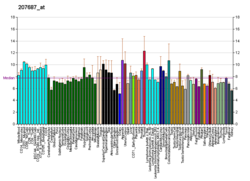INHBC
Protein-coding gene in the species Homo sapiens
| INHBC | |||||||||||||||||||||||||||||||||||||||||||||||||||
|---|---|---|---|---|---|---|---|---|---|---|---|---|---|---|---|---|---|---|---|---|---|---|---|---|---|---|---|---|---|---|---|---|---|---|---|---|---|---|---|---|---|---|---|---|---|---|---|---|---|---|---|
| Identifiers | |||||||||||||||||||||||||||||||||||||||||||||||||||
| Aliases | INHBC, IHBC, inhibin beta C, inhibin beta C subunit, inhibin subunit beta C | ||||||||||||||||||||||||||||||||||||||||||||||||||
| External IDs | OMIM: 601233; MGI: 105932; HomoloGene: 21142; GeneCards: INHBC; OMA:INHBC - orthologs | ||||||||||||||||||||||||||||||||||||||||||||||||||
| |||||||||||||||||||||||||||||||||||||||||||||||||||
| |||||||||||||||||||||||||||||||||||||||||||||||||||
| |||||||||||||||||||||||||||||||||||||||||||||||||||
| |||||||||||||||||||||||||||||||||||||||||||||||||||
| |||||||||||||||||||||||||||||||||||||||||||||||||||
| Wikidata | |||||||||||||||||||||||||||||||||||||||||||||||||||
| |||||||||||||||||||||||||||||||||||||||||||||||||||
Inhibin beta C chain is a protein that in humans is encoded by the INHBC gene.[5][6]
This gene encodes the beta C chain of inhibin, a member of the TGF-beta superfamily. This subunit forms heterodimers with beta A and beta B subunits. Inhibins and activins, also members of the TGF-beta superfamily, are hormones with opposing actions and are involved in hypothalamic, pituitary, and gonadal hormone secretion, as well as growth and differentiation of various cell types.[6]
References
- ^ a b c GRCh38: Ensembl release 89: ENSG00000175189 – Ensembl, May 2017
- ^ a b c GRCm38: Ensembl release 89: ENSMUSG00000025405 – Ensembl, May 2017
- ^ "Human PubMed Reference:". National Center for Biotechnology Information, U.S. National Library of Medicine.
- ^ "Mouse PubMed Reference:". National Center for Biotechnology Information, U.S. National Library of Medicine.
- ^ H tten G, Neidhardt H, Schneider C, Pohl J (Feb 1995). "Cloning of a new member of the TGF-beta family: a putative new activin beta C chain". Biochem Biophys Res Commun. 206 (2): 608–13. doi:10.1006/bbrc.1995.1086. PMID 7826378.
- ^ a b "Entrez Gene: INHBC inhibin, beta C".
Further reading
- Bernard DJ, Chapman SC, Woodruff TK (2001). "Mechanisms of inhibin signal transduction". Recent Prog. Horm. Res. 56: 417–50. doi:10.1210/rp.56.1.417. PMID 11237224.
- Mathews LS, Vale WW (1991). "Expression cloning of an activin receptor, a predicted transmembrane serine kinase". Cell. 65 (6): 973–82. doi:10.1016/0092-8674(91)90549-E. PMID 1646080. S2CID 36407277.
- Schmitt J, Hötten G, Jenkins NA, et al. (1997). "Structure, chromosomal localization, and expression analysis of the mouse inhibin/activin beta C (Inhbc) gene". Genomics. 32 (3): 358–66. doi:10.1006/geno.1996.0130. PMID 8838799.
- Thomas TZ, Chapman SM, Hong W, et al. (1998). "Inhibins, activins, and follistatins: expression of mRNAs and cellular localization in tissues from men with benign prostatic hyperplasia". Prostate. 34 (1): 34–43. doi:10.1002/(SICI)1097-0045(19980101)34:1<34::AID-PROS5>3.0.CO;2-K. PMID 9428386. S2CID 45515214.
- Mellor SL, Cranfield M, Ries R, et al. (2001). "Localization of activin beta(A)-, beta(B)-, and beta(C)-subunits in humanprostate and evidence for formation of new activin heterodimers of beta(C)-subunit". J. Clin. Endocrinol. Metab. 85 (12): 4851–8. doi:10.1210/jcem.85.12.7052. PMID 11134153.
- Casagrandi D, Bearfield C, Geary J, et al. (2003). "Inhibin, activin, follistatin, activin receptors and beta-glycan gene expression in the placental tissue of patients with pre-eclampsia". Mol. Hum. Reprod. 9 (4): 199–203. doi:10.1093/molehr/gag029. PMID 12651901.
- Mellor SL, Ball EM, O'Connor AE, et al. (2003). "Activin betaC-subunit heterodimers provide a new mechanism of regulating activin levels in the prostate". Endocrinology. 144 (10): 4410–9. doi:10.1210/en.2003-0225. PMID 12960042.
- Ushiro Y, Hashimoto O, Seki M, et al. (2007). "Analysis of the function of activin betaC subunit using recombinant protein". J. Reprod. Dev. 52 (4): 487–95. doi:10.1262/jrd.17110. PMID 16627954.
- v
- t
- e
TGFβ receptor superfamily modulators
| ALK1 (ACVRL1) | |
|---|---|
| ALK2 (ACVR1A) | |
| ALK3 (BMPR1A) | |
| ALK4 (ACVR1B) | |
| ALK5 (TGFβR1) |
|
| ALK6 (BMPR1B) | |
| ALK7 (ACVR1C) |
| TGFβR2 |
|
|---|---|
| BMPR2 | |
| ACVR2A (ACVR2) | |
| ACVR2B | |
| AMHR2 (AMHR) |
|
| TGFβR3 (β-glycan) |
|---|
- Endogenous antagonists/inhibitors: BAMBI
- Cerberus (CER1)
- Chordin
- DAN (PARN)
- Decorin
- Follistatin
- Gremlin (Drm)
- LTBP1
- Noggin
- TGIF
- Thrombospondin 1 (THBS1)
- Tomoregulin 1
- Antibodies: Stamulumab (against myostatin)
- TRC105 (against endoglin)
- Others: Endoglin
 | This article on a gene on human chromosome 12 is a stub. You can help Wikipedia by expanding it. |
- v
- t
- e


















